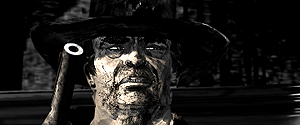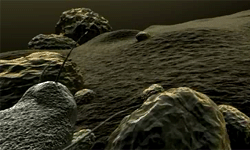John Edgar Park discusses the best films of Siggraph's Electronic Theater. Includes QuickTime movie clips!
This article contains QuickTime movie clips. If you don't have QuickTime get it now!
As technical barriers come down, filmmakers and animators are using computer animation as a true production studio in a box. No longer struggling to obscure a film's CG origins, artists are putting the medium and its many strengths front and center. The Computer Animation Festival at this year's Siggraph, held at the Los Angeles Convention Center from August 12 17 showcased many beautiful examples of CG filmmaking at its finest.
During the Electronic Theater, Siggraph's best-of-the-best screening, audiences were treated to 47 pieces carefully chosen by an expert jury from the record-breaking 678 submissions. Perhaps to punctuate how far visual effects have come from the good old days of B-movie sci-fi, the show opened with an unintentionally comical Flash Gordon episode titled The Planet of Peril. The audience roared with delight as Flash used his wits, charm and physical prowess to escape the certain doom of badly composited "giant" iguanas (who frankly looked bored) and the crab-fisted, stop-motion horror known as Sharkman. Feeling the audience's pain, Flash's curvaceous love-interest provided the perfect segue: "Quick, we must get out of here."
"How?" said Flash.
"The secret door!" she exclaimed.
The secret door opened and, alas, the Electronic Theater began.
The show encompassed CG shorts ranging from scientific explanation to special effects, comic gags to dramatic storytelling. As studios continue to use CGI as a supplement to live-action filmmaking such as the spectacular effects seen in Pearl Harbor and How The Grinch Stole Christmas independent filmmakers and students are embracing the medium for its unique qualities. There were fact-based animations like Rule Based Dynamic Simulation for Wave of Death, the wave sequence from Cast Away and Body Story, a realistic ride through the microscopic workings of the human body. A surprisingly comic reaction was elicited by the presentation of Woodrow Wilson Bridge Project, a pre-visualization of the US$2.2billion construction and engineering project. Must have been the dry voice-over guy. However, the pieces that stood out were those that used CG animation unapologetically for its unique artistic strengths. The development of signature CG styles much like Jeremy Engleman has in his still "paintings" is exciting.
"As we enter the new century, we see that computer graphics has evolved and matured," said Sande Scoredos, Sony Pictures Imageworks and Siggraph 2001 Computer Animation Festival Chair. "We have advanced the technology to a state where anything is achievable and advancement is subtle. Computer graphics is now viewed as another tool in the larger sense of moviemaking for visual storytelling, entertainment and explanation. The work selected this year takes us on a remarkable journey showcasing the talent and brilliance of current and future trends in art and science, and blends it with the very best imagery depicting comedy, drama, action, adventure, fantasy, science-fiction and science fact. The technical and aesthetic perfection that artists reach today is evident throughout the show. Advancements in perfecting photo-realism, radiosity, motion-capture, and how-to explanations of advanced rendering techniques and seamless integration of computer graphic elements into live-action scenes, are just a few of the highlights in an extremely engaging and entertaining festival."
The Films

A sneering cowboy from Angela Jedek's "Where is Frank?" Courtesy of Angela Jedek and SIGGRAPH 2001.
Where is Frank? Dir. Angela Jedek (5:08) This is a classic tale of minding the consequences of your actions. In it a tough looking group of cowboys is waiting around for a train (presumably to rob it?), doing tough cowboy business. Squinting. Sneering. Laughing. Waiting. One grizzled looking guy gets so bothered by a buzzing fly that he shoots it. Only, the ricocheting bullet manages to hit a plank loose, setting into motion a Goldberg-esque demolition of the train station.
Stylistically, the hand drawn India ink textures and unsmoothed polygons create an effect that is unique and fitting. The color palette, traditional camera work and celebration of the polygonal form are somehow more evocative of the Old West than any faded sepia photograph.

A fascinatingly complex shot from Yasuo Ohbas Anjyu. Courtesy of Yasuo Ohba and SIGGRAPH 2001.
Jedek, a student of Germany's Filmakademie Baden-Württemberg, used Maya 3.0 and Photoshop 4.0.
Anjyu Dir. Yasuo Ohba (1:59) Not intended to emulate any one thing in nature, this piece is evocative of watching dancing cilia, joyful fibers or a scrub brush on ecstasy. This procedural animation is pure mathematics as art, a meditative journey into soft, flowing calmness. Derived from complex algorithms, which were then manipulated with a custom program to control the color and appearance of the "characters," this piece is accompanied only by a gentle piano line.
Ohba is a researcher and graphics programmer for Japan's Namco.

Values was this year's big winner. © 2001 Van Phan. Distributed by SND Films.
Values Dir. Van Phan (4:32) Winner Best Animated Short A loving piece about a father-son relationship a less sentimental Cat's in the Cradle by Harry Chapin. Using primitive shapes to avoid facial expressions and lip sync, this touching film portrays a father who puts education above playtime and a son who obediently, but disappointedly, follows. Once grown up, a proud college graduate, the son nearly makes the same blind choice when faced with a joyful child's desire to play ball. Able to see the balance missing in his own upbringing, he chooses to give the child the attention he desires.
Phan's decisions to keep his character designs simple, yet elegant and to lock down his camera give Values visual power. All emotion is conveyed through acting, lighting, staging and form. The keyframe animation is superb.
Phan used Maya 3.0.

View visual music in Pipe Dream. © 2001 Animusic. All Rights Reserved.
Pipe Dream Dir. Animusic (3:27) This is an immensely enjoyable piece that could only come to us through the alchemy of procedural animation techniques. Contained entirely within a room filled with musical instruments and many twisting pipes, the camera shows a ball shoot from a pipe, land on a xylophone key (producing a musical note) and then bounce into a funnel-like receiving pipe. As hundreds of balls fly, strike and return a music composition is played, building in complexity and number of instruments to include ultimately a full drum kit, chimes, keyboards and more. It is a pure joy to watch! Seeing a pattern of balls flying through the air toward their targets makes you join in the fun by trying to read the "score" and anticipate the music before it is made.
Animusic designed their own proprietary software called MIDImotion to control the animation by inputting MIDI music scores as controllers for animation channels.

Watch the trailer for Horses on Mars, and gain a unique, if microscopic, perspective on our Universe. © 2001 Eric Anderson.
Horses on Mars Dir. Eric Anderson (6:56) The story of a 3.5 micron tall microbe and his journey 100 million miles from home. Exploring the theory that microbial life can exist in deep space and travel from planet to planet via volcanic or asteroid-assisted propulsion, this USC student film gives a personal look at one lost soul, searching for meaning and a way home. The existential ponderings of our hero microbe and news of the evolution of his friends ("Hi. Val27 became a horse. I became a Ukranian. How are you?" reads one "postcard" from afar) fill his imagination with visions of returning home one day as a magnificent flying beast. Fate never allows him to complete his journey, but his last hope is that one day they will all meet again as horses on Mars.
The use of CGI to bring microscopic objects to life in a realistic solar system is excellent and it couldn't be convincingly done in any other medium. Beautiful lighting and rendering lend a sense of scale to the story.
Anderson used Maya 2.5, RenderMan Artist Tools, Composer and Premier.
The Siggraph 2001 Computer Animation Festival was a great tribute to the achievements in CG artistry, research and technique of the last year, and an immensely enjoyable experience.
John Edgar Park is a 3D animator, instructor and writer based in Los Angeles. He received his B.A. in Drama from the University of Virginia.







